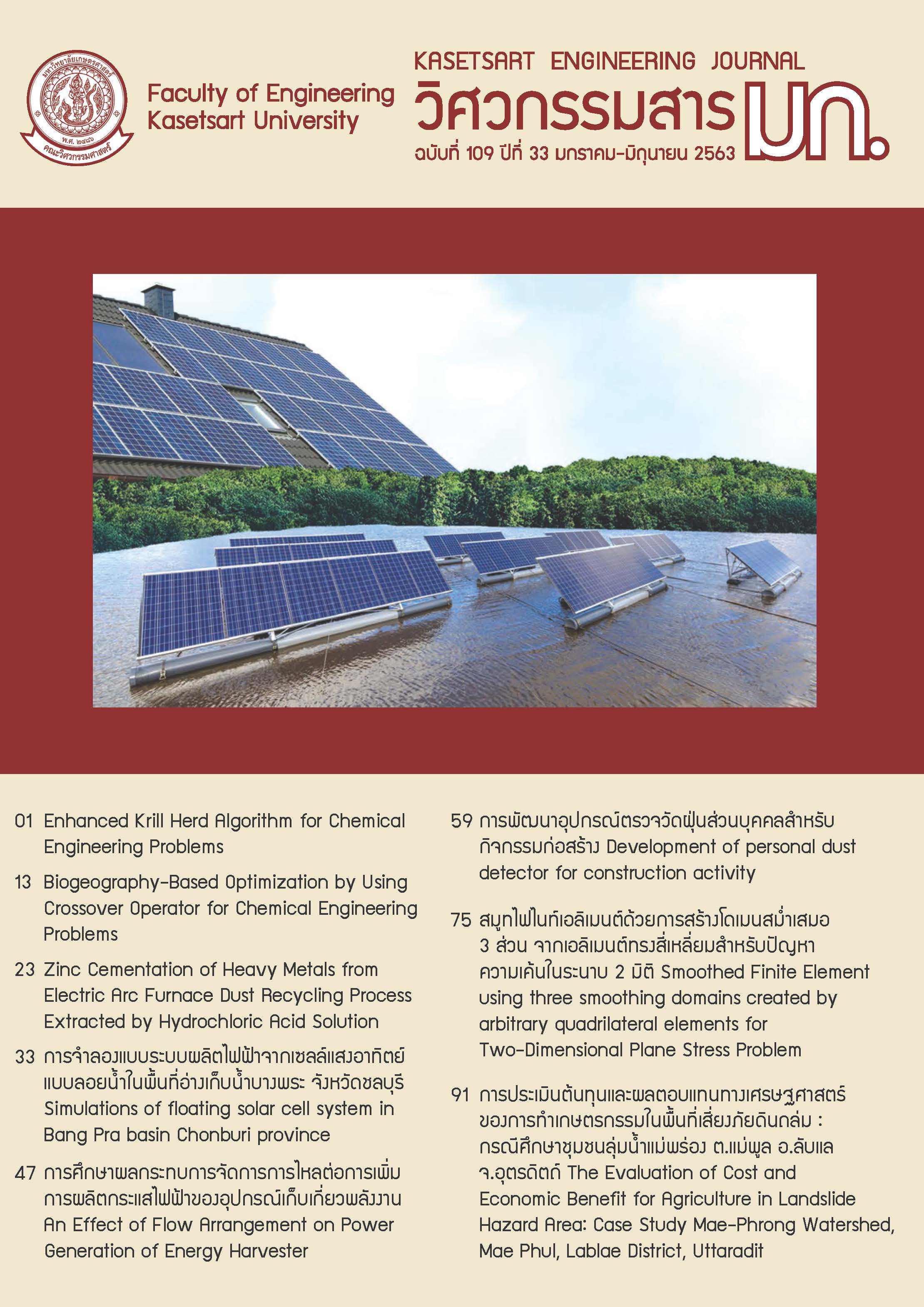Smoothed Finite Element using three smoothing domains created by arbitrary quadrilateral elements for Two-Dimensional Plane Stress Problem
Keywords:
Smoothed finite element, Sub-cell smoothing domains, Strain gradient, Two-dimensional plane stress, Cantilever beamAbstract
The alternative way to create sub-smoothing domains within an element for smoothed finite element analysis was proposed in this research. Three sub-cell smoothing domains were established continuously with the utilization of symmetrical pattern over the entire problem domain. Strain gradient technique is the most important key to distribute strain field smoothly within smoothing domain. Two-dimensional plane stress problem employed for this research was a cantilever beam subjected to parabola shear force with a maximum magnitude of 1000 unit at free end. Two control parameters were used. The first one is meshing ranging from coarse mesh 16x4 to finer mesh 48x12 as the same 4:1 ratio of horizontal to vertical dimension of beam. The latter is measured as fracture of an element side. The values of were 0.2-0.3, 0.3-0.4 and 0.4-0.5 respectively. Numerically evaluated normal and shear stresses over the cross-section area at the middle span and displacement at free end were compared to the exact solutions accordingly. Obviously, the free end displacement accuracy strongly influenced by the second control parameter. The normal stresses at equal to 0.3-0.4 and 0.4-0.5 compared to the exact solutions were found to be at the same accuracy while shear stresses were found to be dependent on mesh size than the value of .
References
Lee NS and Bathe KJ (1993). Effects of element distortions on the performance of isoparametric elements. International Journal for numerical Methods in engineering, 36(20): 3553-76.
Belytschko T, Lu YY and Gu L (1994). Element‐free Galerkin methods. International journal for numerical methods in engineering, 37(2): 229-56.
Babuška I, Banerjee U and Osborn JE (2004). Generalized finite element methods—main ideas, results and perspective. International Journal of Computational Methods, 1(01): 67-103.
Beirão da Veiga L, Brezzi F, Cangiani A, Manzini G, Marini LD and Russo A (2013). Basic principles of virtual element methods. Mathematical Models and Methods in Applied Sciences, 23(01): 199-214.
Francis A, Ortiz‐Bernardin A, Bordas SP and Natarajan S (2017). Linear smoothed polygonal and polyhedral finite elements. International Journal for Numerical Methods in Engineering, 109(9): 1263-88.
Sukumar N and Tabarraei A (2004). Conforming polygonal finite elements. International Journal for Numerical Methods in Engineering, 61(12): 2045-66.
Talischi C, Paulino GH, Pereira A and Menezes IF (2012). PolyMesher: a general-purpose mesh generator for polygonal elements written in Matlab. Structural and Multidisciplinary Optimization, 45(3): 309-28.
Liu G, Dai K and Nguyen TT (2007). A smoothed finite element method for mechanics problems. Computational Mechanics, 39(6): 859-77.
Liu G-R and Trung N (2016). Smoothed finite element methods. CRC press.
Liu G, Nguyen‐Xuan H and Nguyen‐Thoi T (2010). A theoretical study on the smoothed FEM (S‐FEM) models: Properties, accuracy and convergence rates. International Journal for Numerical Methods in Engineering, 84(10): 1222-56.
Lee C-K (2016). Gradient smoothing in finite elasticity: near-incompressibility. Cardiff University.
Dai K and Liu G (2007). Free and forced vibration analysis using the smoothed finite element method (SFEM). Journal of Sound and Vibration, 301(3-5): 803-20.
Nguyen‐Xuan H and Nguyen‐Thoi T (2009). A stabilized smoothed finite element method for free vibration analysis of Mindlin–Reissner plates. Communications in Numerical Methods in Engineering, 25(8): 882-906.
Bordas SP, Rabczuk T, Hung N-X, Nguyen VP, Natarajan S, Bog T et al. (2010). Strain smoothing in FEM and XFEM. Computers & structures, 88(23-24): 1419-43.
Dai K, Liu G and Nguyen T (2007). An n-sided polygonal smoothed finite element method (nSFEM) for solid mechanics. Finite elements in analysis and design, 43(11-12): 847-60.
MATLAB. 9.7.0.1190202 (R2019b). Natick, Massachusetts: The MathWorks Inc.; 2018.
Felippa CA (2004). Introduction to finite element methods. University of Colorado.
Hildebrand FB (2012). Methods of applied mathematics. New York: Dover Publications.
Liu G (2008). A generalized gradient smoothing technique and the smoothed bilinear form for Galerkin formulation of a wide class of computational methods. International Journal of Computational Methods, 5(02): 199-236.
Liu G-R (2009). Meshfree methods: moving beyond the finite element method. Taylor & Francis.
Timoshenko SP and Goodier JN (1970). Theory of Elasticity (3rd edition). New York: McGraw-Hill.


